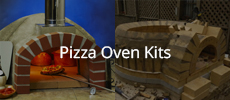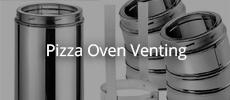Originally posted by Toiletman
View Post
Announcement
Collapse
No announcement yet.
31"/800mm in Eindhoven, the Netherlands: Design critique and build topic
Collapse
X
-
I'm not 100% sure what you've done here. I thought you were creating a sleeve, that I detailed previously, so the flue pipe could be removable. It looks like you didn;t do this and have surrounded the flue pipe seating with the 5:1 vermicrete. Because as it appears you have a double flue pipe, If that is correct, you do not want any kind of homebrew or cement render reinforcing around the inner pipe. I would be better if you extend the vermicrete around the inner pipe up to the base of the outer pipe as the same diameter as the outer pipe. (as shown in attached sketch) Then you can then more safely render over the vermicrete and around the outer pipe, but I'd still be leaving a small gap (5mm or so that can be filled with high temp silicone because the outer pipe at that position gets pretty hot.
Last edited by david s; 03-29-2025, 02:09 PM.Kindled with zeal and fired with passion.
-
Thanks for chipping in David. Below is a sketch of what I did, hope it clarifies it a little bit.Originally posted by david s View PostI'm not 100% sure what you've done here. I thought you were creating a sleeve, that I detailed previously, so the flue pipe could be removable. It looks like you didn;t do this and have surrounded the flue pipe seating with the 5:1 vermicrete. Because as it appears you have a double flue pipe, If that is correct, you do not want any kind of homebrew or cement render reinforcing around the inner pipe. I would be better if you extend the vermicrete around the inner pipe up to the base of the outer pipe as the same diameter as the outer pipe. (as shown in attached sketch) Then you can then more safely render over the vermicrete and around the outer pipe, but I'd still be leaving a small gap (5mm or so that can be filled with high temp silicone because the outer pipe at that position gets pretty hot.
I have a double-walled pipe, and have built the sleeve as you sketched before to make it removable. Your sleeve has tabs on the bottom to fit into the castable, but I'm not sure if you also used tabs on the top to actually hold the pipe, or if you do that just on friction? I also put tabs there, to make sure the pipe always gets back to the same position.
Some questions:- The double walled chimney pipe is now supported on the inner pipe, on the tabs in the adapter. My feeling is that it would be more robust to support it on the outer rim of the outer pipe. I'm not quite sure if supporting it on homebrew castable there would be a good idea: it's a pretty sharp/thin ring, so I'm thinking over time it will cut and wear the homebrew. Maybe better to use a stainless steel ring or put some ceramic mosaic tiles there to actually provide the support?
- How to deal with the void? My feeling is that it's best filled with some insulation material such that the heat won't escape there. Ofcourse it would still need a gap to allow the pipes to slide in, and expand while hot. Therefore I'm leaning towards using vermicrete... probably the more high strength mix, possibly covered with render later? Any tips/idea's?
- You mention that the outer pipe gets pretty in your sketch. I'm not really understanding why? The whole purpose of having a double walled system is to ensure the outer pipe does not get hot right? Hence why I want to fill the void as that's currently the path where heat could escape to the outer pipe.
The damp curing is now done, so I've removed all covering from the oven. Now chopping wood to start the first small curing fire tonight... looking forward to babysitting it with a beer in hand and seeing if the chimney and steam escape paths work as intended.
Attachached also a view from the gallery looking up. I've since removed some of the excess vermicrete that came through the holes for the tabs in the adapter.
1 PhotoOnly dead fish go with the flow
Comment
-
It looks like yoi have a pretty workable solution.
Regarding your questions
I have three little tabs on the bottom of my sleeve adapter. You can see them in the first pic, but it's upside down so they are at the top.the tabs in the middle prevent the sleeve from dropping into the gallery and the cuts in the bottom of the pic show how I locate the sleeve in the gallery and surround it with some homebrew. The second pic shows how this arrangement works (the right way up) also showing the plastic which makes removal of the inner pipe after adding the homebrew around the sleeve, easier.
The third pic shows an oven with a double flue with the outer pipe seating on the terra cotta cap that sits around the inner pipe (although this one does not have a sleeve for inner pipe removal). If you want to be able to remove both pipes, you will probably need to use some long stainless screws to join both pipes at the top and the bottom.
Regarding heat in that area, yes it does get hot there, it's not very far from the flames that just lick around the top of the oven mouth and into the gallery. After an hour or two of firing you can't hold your hand on it. But up at the top where the outer pipe is fixed against the top rafter of the pergola, it's quite cool. I have blanket stuffed in between the two pipes both at the top and at the bottom for correct location as much as heat prevention. You will probably find yours is much the same once you crank it up.
Kindled with zeal and fired with passion.
Comment
-
Thanks David, that clears some of the uncertainty up.Originally posted by david s View PostIt looks like yoi have a pretty workable solution.
Regarding your questions
Then for the oven progres: I lit the first curing fire today! And like so many others before me.... it went to hot and cracked the entry arch :-/. Oh well, it doesn't affect the oven function and all ovens have cracks right?
For the curing scheme I went with the firebrickco's recommendations of a 200x200mm fire x 3 hours the first two days, and then slightly going bigger in the coming days. I asked chatGPT to summarize the forum's curing scheme and got:
for all days: 6hrs at temperature:
1: 150C / 300F
2: 170C / 350F
3: 204C / 400F
4: 232C / 450F
5: 260C / 500F
It was quite difficult to keep the temperatures at 150C/300F, especially while also trying to keep the fire going. Typically it was more towards 170C / 350F, which is probably one of the reasons for the crack in the entry arch to appear: Uneven expansion of the dome due to the too large temperature gradients.
One cool thing to notice: the extension of the mosaic tiles under the ceramic blanket does provide a path for steam to escape. There was noticeably warmer air flowing from the weep holes underneath the oven.
Also: the chimney seemed to work well enough. It was a pretty windy and sunny day today, but the gallery arch is still not blackened at the front. Most smoke went up the chimney.
Enjoy the pictures, I'll keep firing tomorrow. All in all great milestone to enjoy with a beer in hand, tending the fire.
4 PhotosLast edited by Toiletman; 04-05-2025, 02:29 PM.Only dead fish go with the flow
Comment
-
There are those who say their ovens never crack and they also sell used cars too..... That said, lesson learned about going too fast and hot during the curing stage. Turtle wins the race over the rabbit during this phase of WFO construction. A crack in the arch is fairly common and the arch is self supporting so no structural issues there. Enjoy the oven.
- Likes 1
Comment
-
Netjes gedaan hoor, Ik benijd je zorgvuldigheid en je vaardigheden in 3d tekenen.
Well done, But The italian way is easier building the dome.
https://www.youtube.com/watch?v=pXrQ...oklynPizzaCrew the first 40 seconds
- Likes 1
Comment
-
Toiletman , A little late for you, but for others following your progress...
I found some small heavy gauge wire baskets (origin unknown) at my parents house. I used 3 and made small fires with strips of wood and charcoal briquettes. That kept me from adding too much fuel and the hot charcoal ignited new wood. The baskets allowed me to move the fires around to expose different parts of the dome to the heat and not over heat one area too much during the early drying stages.
I was (visible) crack free for quite a while. I think it was the 6th or 7th full firing that I noticed a vertical crack in the dome starting about course 5 and climbing 3-4 courses at about 10 o'clock relative to the floor. As most report, it opens when the temp exceeds 1000 F and closes as the oven cools.
You may have had a crack no matter how you did the drying fires. I believe the variation in the bricks and their positioning plus differences in thickness of the mortar joints, all when subjected to heat, creates stresses in ways that crack locations will be predicted only by sophisticated AI modelling.
Comment
-
I was concerned about trying to keep the first day or 2 low enough temperature wise. The only thing i could think of was to burn charcoal or heat beads. With that i was able to hold the temperature to about 200F the first day and closer to 250F the 2nd day. Then slowly climb as the days went on. I also did my best to do almost all of them back to back so the oven never fully cooled of between fires.
Comment
-
Wow, it's been ages since I posted here! Well, some major milestones to report:- Cooked my first (Turkish) pizza in the oven!
- Managed to clear the dome
- Managed to get some leftover tiles for cheap, and have cut them to size to make the table around the oven
- Wanting to finish the above first I'm still waiting with applying the stucco layers
- More cracks! During the high temperature firing the front of the gallery arch cracked. I guess it's due to the back of the gallery arch having insulation and the front not. So lesson for next time is to have less insulation on the rear. Also the vermicrete is lifting and creating a gap between the arch and the vermicrete. I'm not really sure why that happens, maybe the bricks push it up when expanding and then when shrinking down again it doesn't fully settle back down? For the stucco coat I'm planning on adding some high temperature silicone around the gap, and then stucco over it using reinforcement. The final seal is going to be done with flexible paint, but that will probably not bridge such a large gap.
- My firewood stock has been depleted, so for the next firing I need to find a local supply as well as build a rack (planning on using the space behind the oven for that)
6 PhotosOnly dead fish go with the flow
Comment
-
Toiletman I had some cracks in the pericrete around my arch. Decided to use some high temp silicone and glue a 1/2" dia ceramic fiber rope at the interface. Then used it as a curb to add another layer of pericrete. The final painted on sealer encapsulated any remaining areas of the rope. That seems to provide a little flexibility at that juncture. No cracks since.
- Likes 1
Comment
-
Small update:
Fitted and pointed the tiles, put in the first layer of stucco (in 3 loads, and it wasn't enough to finish the **# chimney. However, it looks and feels a whole lot more mature now. Looking forward to the final render layer to make it look a little bit more smooth and then seal it in.
Giovanni Rossi Good solution. I was also counting on a paintable bead of flexible kit and then covering it with sealant. It should be more than flexible enough for such a small crack.
4 PhotosOnly dead fish go with the flow
Comment
-
You can enhance the strength of the outer render substantially by wrapping the whole oven in cling wrap and leaving it for a week. This will hold moisture in the outer layer. A second reason to do this is because the dry vermicrete will be pulling moisture out of the render..Kindled with zeal and fired with passion.
Comment
-
It's been under a wet blanked and a plastic sheet after final sponging... it was crazy hot here, so took great care to mix with cold water and keep the substrate moist when applying...Originally posted by david s View PostYou can enhance the strength of the outer render substantially by wrapping the whole oven in cling wrap and leaving it for a week. This will hold moisture in the outer layer. A second reason to do this is because the dry vermicrete will be pulling moisture out of the render..
Applying render and getting it smooth was quite a challenge... I had to start on the front of the dome, as that would get sun during the day, but it got too hard while I was working on the back. I tried sponging some of the high spots down, but it was too late. The goal was to have a strong outer layer and have the insulation protected from rain, so I'll probably just seal it now and then see if I'll maybe later paint it to disguise it more... At the moment it stands out very much due to the sponging bringing out the sand particles in the low spots...
I didn't have enough render to finish the whole dome during the day, but at night I mixed a little bit extra to finish the gap in the back... of course that turned out to be the smoothest... well, you live and learn :-/
Sealing it next week, and then going on holiday. Probably will use curing fires again after the holiday to get to pizza baking... There must be such an amount of moisture going into it now due to all the render and pre-wetting.
3 PhotosOnly dead fish go with the flow
Comment





Comment